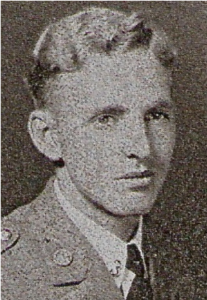Scroll of Honor – Alexander Fraser Henderson, Jr.
Deadliest Season
Written by: Kelly Durham
Clemson’s Scroll of Honor, which lists alumni who died while on  military duty, includes four hundred ninety-three names reaching back to 1918 and the Great War, now better known as World War I. The list continues through the Twentieth Century and includes Clemson’s fallen from the Nicaraguan Campaign, Korea, Vietnam, and the Cold War. The Scroll also lists Clemson alumni who have fallen in this century’s War on Terror. The deadliest conflict was World War II, which claimed the lives three hundred seventy-four Clemson men, seventy-six percent of all those listed on the Scroll of Honor.
military duty, includes four hundred ninety-three names reaching back to 1918 and the Great War, now better known as World War I. The list continues through the Twentieth Century and includes Clemson’s fallen from the Nicaraguan Campaign, Korea, Vietnam, and the Cold War. The Scroll also lists Clemson alumni who have fallen in this century’s War on Terror. The deadliest conflict was World War II, which claimed the lives three hundred seventy-four Clemson men, seventy-six percent of all those listed on the Scroll of Honor.
Alexander Fraser Henderson, Jr. is one of those World War II veterans. Henderson died in France on July 6, 1944, only a month after the D-Day landings began the liberation of western Europe. Henderson attended Clemson from 1934 to 1936 as a general science major in the Class of 1938. Born in Ehrhardt, Henderson also attended Davidson College.
After leaving school, Henderson worked as the assistant cashier at the Farmers and Merchants Bank in Walterboro before volunteering for Army service. Following his initial training, Henderson was stationed in Iceland, where the Army assigned him to the finance office. Apparently, Henderson wanted to make a greater contribution to the war effort, so he volunteered again, this time for the Infantry. He was ordered to Fort Benning, Georgia where he completed officers’ candidate school and earned his commission as a second lieutenant in early 1944.
As a freshly minted officer, Henderson shipped out to England, where he joined up with forces destined for the invasion of Europe. On July 6, Henderson was killed in action in France and buried at Blossville.
Henderson fell during what would become the deadliest season of the deadliest war for Clemson men. From the United States’ entry into the war through May 1944, one hundred thirty-nine Clemson alumni died on military duty—in training accidents, from illness, and in combat—an average of less than four per month.
Following the D-Day landings in June 1944, the casualty rates for the United States in general and Clemson men in particular soared. From D-Day until the end of the year, a period which included not only the liberation of France but the invasion of the Philippines and the Battle of the Bulge as well, Clemson men died at a rate of more than sixteen per month—a somber four-fold increase.
The dying would continue into 1945, but the rate of death  would—mercifully—begin to decline, dropping to thirteen per month as first the Germans and then the Japanese were battered into surrender. Clemson’s last combat death of World War II occurred on September 1, 1945, the day before the formal surrender ceremony in Tokyo Bay that marked the formal end to a conflict that claimed more than fifty million lives worldwide.
would—mercifully—begin to decline, dropping to thirteen per month as first the Germans and then the Japanese were battered into surrender. Clemson’s last combat death of World War II occurred on September 1, 1945, the day before the formal surrender ceremony in Tokyo Bay that marked the formal end to a conflict that claimed more than fifty million lives worldwide.
Following the war, Henderson’s remains were returned to the United States and buried in Colleton County’s Live Oak Cemetery. He was survived by his parents, a brother and a sister.
For additional information on Alexander Fraser Henderson, Jr. see:
For more information about Clemson University’s Scroll of Honor see:
